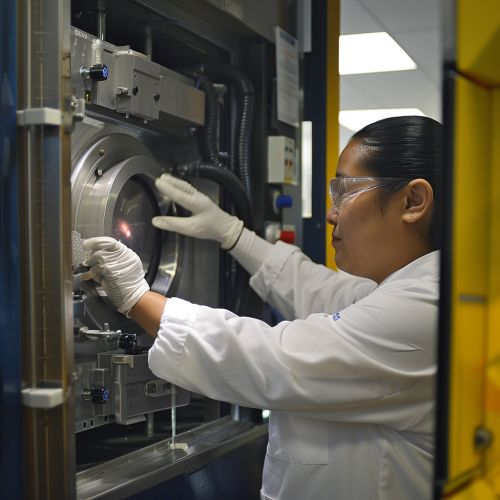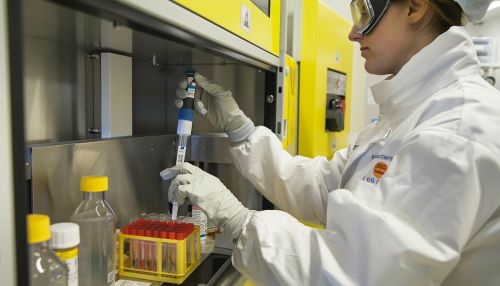Radioisotope: Difference between revisions
(Created page with "== Introduction == A '''radioisotope''', also known as a radioactive isotope, is an isotope of an element that has an unstable nucleus and emits radiation during its decay to a stable form. Radioisotopes can occur naturally or be artificially produced in nuclear reactors or particle accelerators. They have a wide range of applications in various fields, including medicine, industry, agriculture, and scientific research. == Properties of Radioisotopes == Radioisotopes...") |
No edit summary |
||
| (One intermediate revision by the same user not shown) | |||
| Line 66: | Line 66: | ||
== References == | == References == | ||
[[Image:Detail-79729.jpg|thumb|center|A laboratory technician handling a sample of a radioisotope in a controlled environment.|class=only_on_mobile]] | |||
[[Image:Detail-79730.jpg|thumb|center|A laboratory technician handling a sample of a radioisotope in a controlled environment.|class=only_on_desktop]] | |||
[[Category:Radioactive Isotopes]] | [[Category:Radioactive Isotopes]] | ||
[[Category:Nuclear Medicine]] | [[Category:Nuclear Medicine]] | ||
[[Category:Radiation]] | [[Category:Radiation]] | ||
Latest revision as of 22:14, 19 May 2024
Introduction
A radioisotope, also known as a radioactive isotope, is an isotope of an element that has an unstable nucleus and emits radiation during its decay to a stable form. Radioisotopes can occur naturally or be artificially produced in nuclear reactors or particle accelerators. They have a wide range of applications in various fields, including medicine, industry, agriculture, and scientific research.
Properties of Radioisotopes
Radioisotopes are characterized by their radioactive properties. The decay process involves the emission of alpha particles, beta particles, or gamma rays, leading to the transformation of the original isotope into a different element or a different isotope of the same element. The rate of decay is measured by the half-life, which is the time required for half of the radioactive atoms in a sample to decay.
Types of Radiation
- Alpha Radiation: Consists of helium nuclei and is the least penetrating form of radiation. It can be stopped by a sheet of paper or human skin.
- Beta Radiation: Consists of high-energy electrons or positrons and has greater penetration than alpha radiation. It can be stopped by a few millimeters of aluminum.
- Gamma Radiation: Consists of high-energy photons and is the most penetrating form of radiation. It requires dense materials like lead or several centimeters of concrete to be effectively shielded.
Production of Radioisotopes
Radioisotopes can be produced through several methods:
- Nuclear Fission: Involves the splitting of heavy atomic nuclei, such as uranium-235 or plutonium-239, into smaller fragments, releasing a large amount of energy and producing a variety of radioisotopes.
- Neutron Activation: Involves bombarding stable isotopes with neutrons, causing them to capture neutrons and become radioactive.
- Particle Accelerators: Use high-energy particles to bombard target materials, inducing nuclear reactions that produce radioisotopes.
Applications of Radioisotopes
Medical Applications
Radioisotopes play a crucial role in nuclear medicine, where they are used for both diagnostic and therapeutic purposes. Some common applications include:
- Diagnostic Imaging: Radioisotopes such as Technetium-99m are used in single-photon emission computed tomography (SPECT) and positron emission tomography (PET) scans to visualize and diagnose conditions within the body.
- Cancer Treatment: Radioisotopes like Iodine-131 and Cobalt-60 are used in radiotherapy to target and destroy cancerous cells.
Industrial Applications
In industry, radioisotopes are used for various purposes, including:
- Radiography: Used to inspect the integrity of materials and structures by revealing internal defects through the use of gamma rays or X-rays.
- Tracer Studies: Radioisotopes are used as tracers to study the movement of substances within systems, such as the flow of liquids in pipelines or the distribution of fertilizers in soil.
Agricultural Applications
Radioisotopes are also employed in agriculture to improve crop yields and control pests:
- Mutation Breeding: Exposure of seeds to radiation to induce beneficial mutations that can lead to improved crop varieties.
- Pest Control: Use of radiation to sterilize insects, reducing their population through the sterile insect technique.
Safety and Handling
The use of radioisotopes requires strict safety measures to protect individuals and the environment from radiation exposure. Key safety practices include:
- Shielding: Using appropriate materials to block or reduce radiation exposure.
- Distance: Maintaining a safe distance from radioactive sources to minimize exposure.
- Time: Limiting the amount of time spent near radioactive sources to reduce exposure.
Environmental Impact
Radioisotopes can have significant environmental impacts if not managed properly. Radioactive waste generated from medical, industrial, and research activities must be carefully handled, stored, and disposed of to prevent contamination of the environment and harm to living organisms.
See Also
References


